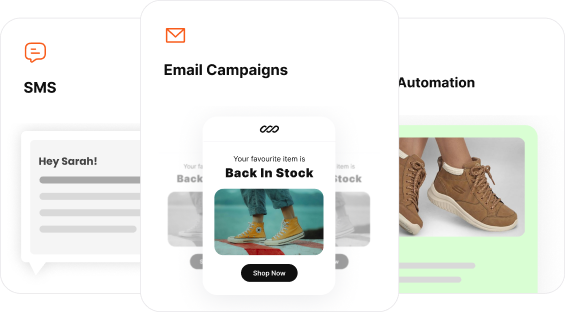These emails drive 8.5% of total email revenue and earn 293% more per email than standard campaigns – all from shoppers who never even made it to checkout.
But here’s the challenge: most of these visitors aren’t ready to buy. They’re simply browsing, comparing options, or window shopping. That’s why the usual generic “We saw you looking…” email often fails to bring them back.
In this article, we’ve shared how to turn casual browsers into customers.
Topics covered:
- What a browse abandonment email is?
- Strategies for creating a high-converting browse abandonment email
- How to set up your browse abandonment automation workflow
- Browse abandonment email examples, templates, and subject lines
- Common troubleshooting issues with browse abandonment workflows
TLDR: Browse abandonment email key stats
- 9.6x higher conversion rate: Browse abandonment emails convert at 0.96%, which is 9.6 times higher than the average email campaign (0.10%).
- High open rates: These targeted emails achieve an impressive 34.55% to 41.18% open rate, outperforming general promotional emails.
- Strong click-to-conversion: Around 10% of all clicks on a browse abandonment email lead directly to a purchase.
- Significant audience volume: For every 10 visitors, 9 leave the store without adding products to their cart.
- “Just browsing” factor: Even among cart abandoners, 43% were simply browsing, highlighting how low intent often starts early in the buying journey.
Set up your browse abandonment email workflows without the complexity using Retainful’s pre-built workflows.
What are browse abandonment emails?
A browse abandonment email is a personalized, automated email sent when a shopper visits your website and views specific products or categories. It triggers automatically if the visitor leaves without adding anything to their cart or starting a purchase.
The primary goal is not to immediately secure a sale. However, it can rekindle interest and provide the necessary information, or nudge the shopper to continue their research.
For example, let’s say a shopper visits your store and checks out a pair of running shoes, but leaves without adding them to the cart or purchasing.
A few hours later, they will automatically receive a browse abandonment email. This gentle reminder encourages the shopper to return and complete their purchase.
Browse abandonment vs. cart abandonment vs. product abandonment
| Feature | Browse abandonment | Cart abandonment | Product abandonment |
| User action | Visited the site and viewed multiple pages/categories, but did not view a specific product page repeatedly or add to cart. | Added item(s) to the cart but exited the site before completing the purchase. | Visited the site and viewed a specific product page one or more times but did not add to cart. |
| Purchase intent | Low. | High. | Medium. |
| Messaging focus | Category/Brand Nurturing. Gentle re-engagement, discovery, and brand education. | Transaction Completion. Resolves final hurdles (e.g., shipping, trust, price). | Specific Item Focus. Showcases the exact product, reviews, and detailed benefits. |
| Content strategy | Recommends bestsellers or items from the category they viewed. | Lists the specific items left in the cart with the total price. | Features the exact item with high-quality visuals. |
| Tone of email | Soft & helpful. | Urgent & direct. | Engaging & informative. |
| Discount usage | Rarely used. | Commonly used. | Sometimes used. |
| Goal | Move the customer from browsing to specific product consideration. | Move the customer from an abandoned cart to completing the purchase. | Move the customer from consideration to adding the item to the cart. |
Create all the e-commerce email, SMS, and WhatsApp workflows using a single platform – Retainful
Why do e-commerce businesses need automated browse abandonment emails?
Over 78% of visitors browse but never add to the cart. Some reasons for browse abandonment include comparison shopping, research, high prices, distractions, or low intent.
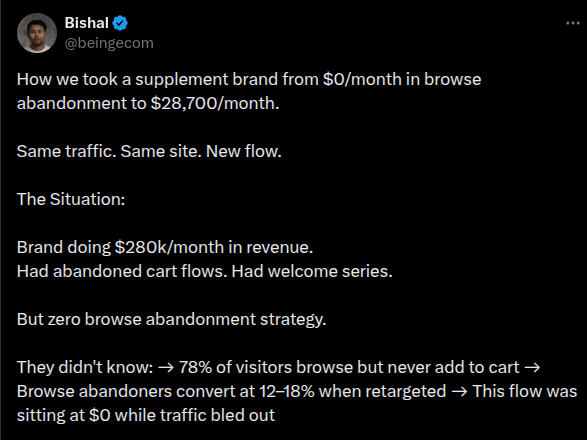
Source: X (Twitter)
To rekindle their interest and recover the sales, browse abandonment emails are necessary.
The top 5 key benefits of browse abandonment emails to e-commerce stores are
- Recovers a vast amount of lost revenue: Most shoppers leave a site without adding anything to their cart. Browse abandonment emails target this large group with personalized messages. This gives a strong boost to your overall revenue and email ROI.
- Captures early-stage purchase intent: These emails reach visitors who showed interest by viewing a product or category but didn’t take the next step. A timely, gentle reminder moves them from the research stage to the consideration stage.
- Enhances personalization and relevancy: Unlike generic marketing emails, browse abandonment messages use real browsing data. This makes the email more personalized, engaging, and likely to get clicks.
- Increases brand recall and nurturing: In a crowded marketplace, shoppers can easily forget where they saw a product. A well-timed browse abandonment email reminds nurtures leads. It shows that your brand is helpful and attentive — not just trying to sell.
- Fills the top of the automation funnel: Browse abandonment emails bridge the gap between general marketing emails and cart abandonment emails.
Connect with our expert team to set up your browse abandonment workflows without the hassle and turn visitors into customers – Just make a quick call
5 Proven strategies for high-converting browse abandonment emails
The stats are showing the potential of browse abandonment emails. However, the bigger picture is what all the email strategies you must use for creating high-converting browse abandonment workflows.
Here are 5 proven strategies to increase conversions from browse abandonment automations:
- Segment for your browse abandonment emails
- Email cadence and flow strategy
- Maximizing personalization and product display
- Email components
- Role of incentives (When to offer a discount)
Segment for your browse abandonment emails
Effective email segmentation ensures your tone and offers match the customer’s relationship with your brand.
- Targeting first-time browsers:
- Focus:Education and trust-building. The primary goal is to introduce your value proposition.
- Content: Focus on your brand’s unique selling points (USPs), superior customer service, easy return policies, and general brand story. Use the viewed product as an anchor, but surround it with information that eases initial skepticism.
- Incentives:Avoid offering a discount in the first email. Save it to prevent training new customers to always expect a discount.
- Targeting
- Incentives: You may test a small, later-stage discount (e.g., in Email 3) or offer rewards instead of a straight price reduction for loyal customers.
- Focus:Exclusivity and urgency. They know and trust your brand; the goal is to drive the immediate purchase.
- Content: Reference their previous purchase history for more accurate product recommendations. Highlight new arrivals or exclusive access to sales.
Email cadence and flow strategy
The email frequency and timing are key to catching the shopper at the moment of highest recall without being intrusive.
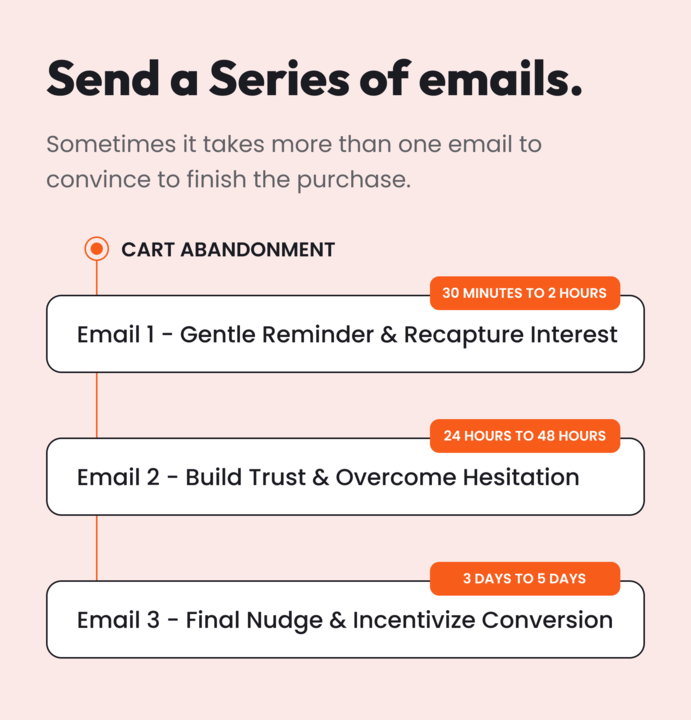
| Recommended time delay | Primary goal | Content | |
| Email 1 | 30 Minutes to 2 Hours | Gentle Reminder & Recapture Interest | Re-display the exact product viewed. Use a soft, non-salesy subject line. Do not include a discount. |
| Email 2 | 24 Hours to 48 Hours | Build Trust & Overcome Hesitation | Feature the product again, but add social proof (customer reviews, ratings, a testimonial). Address common objections. Include a link to an FAQ or Customer Service. |
| Email 3 | 3 Days to 5 Days | Final Nudge & Incentivize Conversion | Create a sense of urgency or scarcity. This is the final opportunity to introduce a coupon if testing shows it’s necessary to close the sale. |
Maximizing personalization and product display
Personalization is the primary driver of open rates and click-through rates in abandonment emails.
- Using customer names: Always use the customer’s name in the subject line. This makes the email feel less like automation and more like a personal check-in.
- Dynamically displaying viewed products and alternatives:
- The “Hero” Product must be the exact item the customer viewed. Make it easy to click back to that product page.
- Below the hero product, use a dynamic section for alternatives orcross-sells. This is crucial if the customer left because the initial product wasn’t exactly right (e.g., “You May Also Like” or “Bestsellers in This Category”).
Role of incentives (When to offer a discount)
As the intent is lower than cart abandonment, incentives must be used judiciously.
- Best practice: Withhold discounts initially. Do not offer a discount in the first 24 hours. The initial abandonment could be due to distraction, not price.
- When to introduce an incentive (Email 3):
- What to offer: Start with a less costly incentive, like Free Shipping or a small percentage discount (e.g., 10%).
- The exclusivity angle: Frame the discount as a “One-Time Offer” or “Gift Just For You,” making it feel exclusive to them for their continued interest.
- What to offer: Start with a less costly incentive, like Free Shipping or a small percentage discount (e.g., 10%).
Email components and layout
Every part of the email design should work together to make the return to your site frictionless. In addition to that, ensure that your emails are responsive to different devices [mobile and tablets].
- Subject line:
- The subject line of your email must align with the stage of the abandonment sequence to set the right tone and expectation.
- The subject line of your email must align with the stage of the abandonment sequence to set the right tone and expectation.
- A clear and compelling Call-to-Action (CTA):
- The CTA must be prominent, brightly colored, and action-oriented.
- Use compelling copy like: “Take Another Look,” “Shop Now,” or “View Your Favorites.”
- Ensure the CTA links directly back to the product page or, at a minimum, the category page.
- The CTA must be prominent, brightly colored, and action-oriented.
- Addressing customer objections:
- Include a small bar or footer icon strip highlighting your top value propositions:
- Free Shipping/Returns (if applicable)
- Warranties/Guarantees
- Customer Support contact (e.g., “Need Help? Chat with us.”)
- Include a small bar or footer icon strip highlighting your top value propositions:
- Leveraging social proof:
- Incorporate star ratings below the product image.
- Use a direct quote from a testimonial in the email body (especially in Email 2) to build confidence and mitigate risk.
30 Browse abandonment email subject lines that get clicks
Soft nudges and reminders (Email 1)
Goal: Gentle re-engagement, sent within 30 minutes to 2 hours.
- Did something special catch your eye, [Name]?
- Your favorites are still here, [Name].
- We saved your spot: [Product/Category] is waiting.
- Just checking in on the [Product Name] you liked.
- Hey [Name], did you mean to hit checkout?
- Need a second look at the [Product Name]?
- The [Category] collection you viewed is still trending.
- Don’t lose track of your great taste, [Name].
- We noticed you were looking at something awesome.
- Did you forget to click back, [Name]?
Build trust & overcome hesitation (Email 2)
Goal: Provide reassurance and value, sent within 24–48 hours.
- Why customers are loving the [Product Name] (Just check the reviews!)
- Your [Category] picks come with free shipping.
- Over 1,000 shoppers are viewing the [Product Name] this week.
- Read this before you decide on the [Product Name].
- [Name], have questions about the [Product Name]? We can help.
- Unsure about sizing? Check out our fit guide for the [Product Name].
- The [Product Name] is backed by our full money-back guarantee.
- See why the [Product Name] has a 4.9-star rating!
- We make returns easy (just in case you were worried).
- [Name], get peace of mind with our 24/7 customer support.
Creating urgency, scarcity, and FOMO (Email 3)
Goal:Drive immediate action, sent after 3-5 days, often with an incentive.
- LAST CHANCE: Your favorite [Product Name] is almost gone!
- Hurry! Limited stock remaining for the [Product Name].
- [Name], don’t miss out on the [Product Name] before it sells out.
- Your special 10% offer on the [Product Name] expires soon!
- Final Call! Take an extra 15% off your browsed items.
- [Product Name] is reserved for a limited time—act now, [Name].
- Going, going… [Product Name]! Grab yours before it’s too late.
- Only 2 left: Secure your [Product Name] today!
- A special reward is waiting for you back in the [Category] section.
- Don’t let your dream [Product Name] get away, [Name].
5 Best browse abandonment email examples
We’ve rounded up 5 great browse abandonment email examples and unpacked what makes each one work. So you can grab the key takeaways and use them in your own email campaigns.
- Chewy’s emotional & frictionless browse abandonment email example
- AllTrails service abandonment email example
- Sometimes Always – flattery & scarcity-driven abandonment email
- Patagonia’s brand-building & content-driven browse abandonment email example
- OluKai’s branded & value-focused product abandonment email
Chewy’s emotional & frictionless browse abandonment email example

Key takeaways:
- Keep the tone light and conversational: Write playful, friendly copy that feels natural and non-pushy. Humor and warmth can re-engage shoppers without pressuring them.
- Include dual CTAs: Add both a primary CTA in the hero banner and a secondary one near the product. This gives shoppers multiple chances to click and return to their browsing session.
- Reduce friction with trust signals: Highlight key benefits like free delivery, easy returns, or money-back guarantees using icons or badges. These remove hesitation and build confidence to buy.
- Show social proof upfront: Display product ratings or stars near the product name to reassure shoppers of quality and credibility.
- Offer direct support options: Add clear customer support details (like a phone number or chat link). This helps hesitant shoppers get answers quickly and complete their purchase.
AllTrails browse abandonment email example
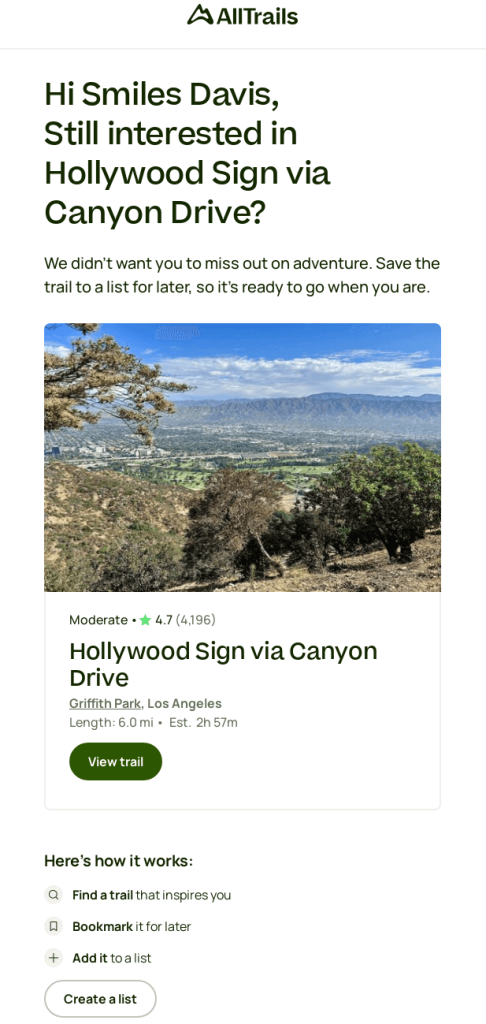
Key takeaways:
- Personalize the headline and body: Use the customer’s name and include the exact product or item they viewed to make the email feel highly relevant.
- Offer a low-commitment next step: Instead of pushing for a purchase, encourage smaller actions like “Add to Wishlist” or “Check Price.”
- Include key product details and social proof: Display important info like price, availability, and star ratings directly in the email to help shoppers make quick decisions.
- Reinforce your value proposition: Add a short “How it works” or “Why shop with us” section to remind users of your brand’s benefits and encourage re-engagement.
Sometimes Always – flattery & scarcity-driven abandonment email
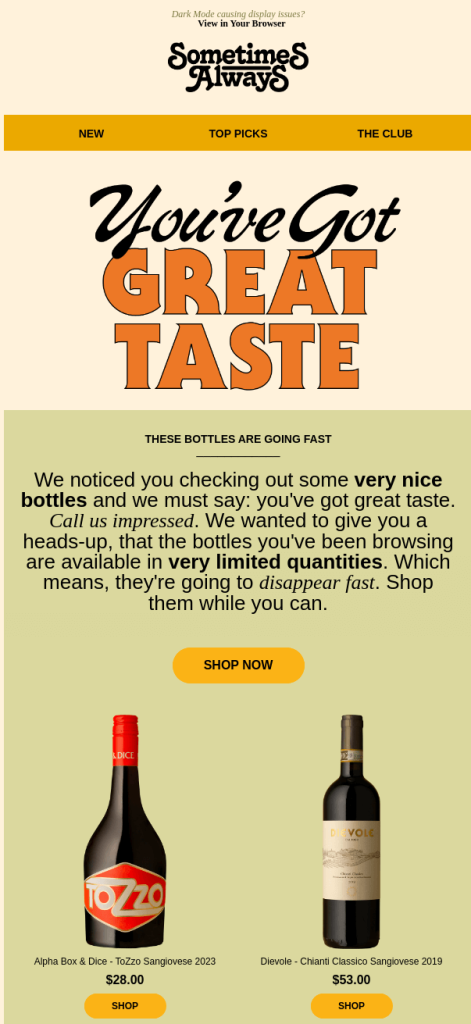
Key takeaways:
- Use flattery in the headline: Compliments like “You’ve got great taste” create a positive emotional connection and make the shopper feel valued.
- Create urgency with FOMO: Use genuine scarcity phrases to build excitement and encourage quick action.
- Show price and CTA together: Place the price and “Shop” button directly under each product to make purchasing easy and intuitive.
- Add a navigation bar for discovery: Include links like “New,” “Top Picks,” or “The Club” so shoppers can explore other options if they skip the featured product.
Patagonia’s brand-building & content-driven browse abandonment email example

Key takeaways:
- Focus on content, not product: Engage low-intent browsers with valuable brand stories or educational content instead of pushing for a sale.
- Include broad, discovery-focused CTAs: Guide users toward content like blogs, videos, or community pages to keep them engaged for future purchases.
- Design strategically for segmentation: Use different layouts or background colors to signal the purpose of each email and match the customer’s intent stage.
- Adopt a non-pushy, grateful tone: Use friendly, appreciative language that builds trust and makes customers feel valued.
OluKai’s branded & value-focused product abandonment email

Key takeaways:
- Use branded, urgency-driven headlines: Combine your brand’s voice with subtle FOMO to create authenticity and motivate quick action.
- Highlight the abandoned product first: Feature the exact item the shopper viewed with a clear “Shop Now” button to recapture attention instantly.
- Add strategic cross-sells: Show similar or related products to keep the shopper engaged if the original item wasn’t a perfect fit.
- Handle objections proactively: Clearly list policies like free shipping, easy returns, and guarantees to remove hesitation and build trust.
- Offer flexible payment options: Include “Pay Over Time” or installment methods to reduce price barriers and encourage higher-value purchases.
Copy and paste the browse abandonment email template
After looking over 100+ browse abandonment emails from brands, we’ve created 3 high-converting copy-paste email templates.
Gentle nudge and reminder
Subject line: Did something special catch your eye, [Name]?
Body copy:
Hi [Name],
We noticed you were checking out some great items in our store, but it looks like you may have gotten distracted! No worries—your favorites are exactly where you left them.
Take a second look at the [Dynamic Product Name].
[Product image]
TAKE ME BACK TO SHOPPING
[Link to Viewed Product Page]
P.S. We offer free delivery on all orders over $75.
Building trust and social proof
Subject line: Good taste, [Name]! That [Product Name] is a favorite.
Body copy:
Hey [Name],
The best decisions are made with confidence.
We wanted to give you a little more information on the [Dynamic Product Name] you were viewing, which happens to be one of our highest-rated items!
⭐️⭐️⭐️⭐️⭐️ 4.9/5 stars!
“Amazing quality and fits perfectly. I use it every day!” – Verified Buyer, Sarah T.
READ CUSTOMER REVIEWS
[Link to Product Reviews Section]
We Have You Covered:
30-Day Easy Returns: No worries if it's not perfect.
1-Year Product Guarantee: Shop with complete peace of mind.
Final reminder (Urgency-driven)
Subject line: LAST CHANCE: Don't let your [Product Name] sell out, [Name]!
Body copy:
Hi [Name],
It’s official: the [Dynamic Product Name] you were viewing is one of our best-sellers, and quantities are running very low.
We wanted to give you a heads-up that this item could disappear fast.
Exclusive Offer, Just For You:
To help you secure your purchase, we're extending a Free Shipping offer on this item for the next 24 hours only.
Price: [Dynamic Price]
Free Shipping Code: SHIPITNOW
SECURE YOUR ORDER NOW
[Link to Product Page with Discount Code Applied]
Don't miss out—once it's gone, it's gone for good!
How to create a browse abandonment automation workflow?
Creating a browse abandonment automation workflow need not be complex. With more marketing automation software like Retainful out there, you can set up your flow effortlessly.
Moreover, using Retainful, you can even set up automated SMS and WhatsApp messages within your browse abandonment workflow. This way, you can create a complete omnichannel marketing experience.
Here are the 5 steps to set up a browse abandonment automation workflow:
- Log in to your Retainful account
- Select a pre-built browse abandonment workflow template
- Customize the trigger, email, and delay time
- Optionally, you can even include SMS or WhatsApp blocks
- Go live
Step 1: Log in to your Retainful account
If you don't have a Retainful account, create one for free - Sign up. In your Retainful dashboard, select the Automation option.

Step 2: Select the pre-built browse abandonment workflow template
In the automations page, click on the Create Workflow button.

Then select the pre-built browse abandonment workflow under the Prevent lost sales category.
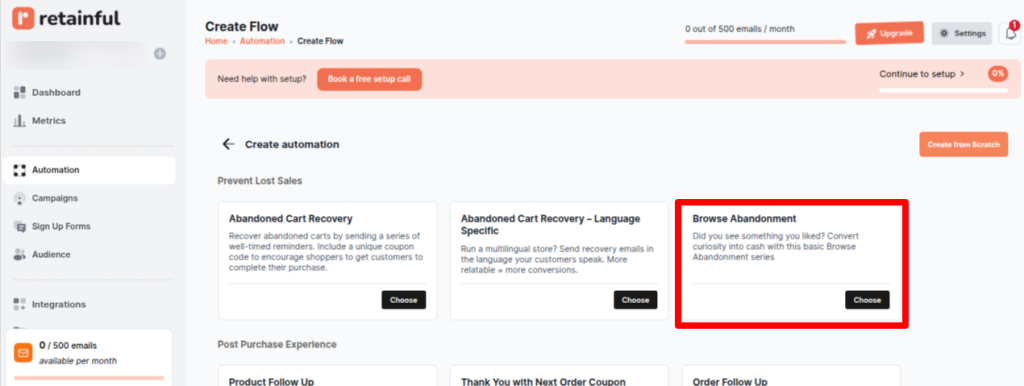
Step 3: Customize the trigger, email, and delay time
To customize any block on the workflow, simply click on it.
Trigger customization: The default trigger in the workflow is When someone viewed the product. You can include additional conditions. Click on the Trigger block.
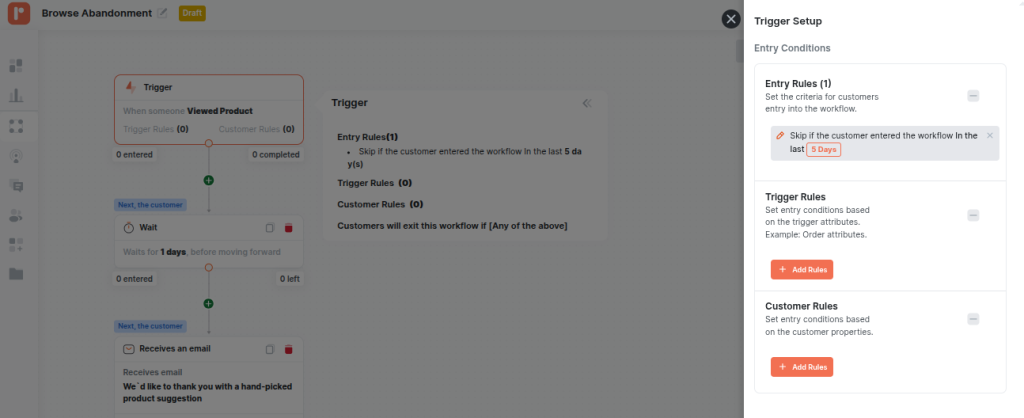
Delay time customization: Click on the Wait block to set the time interval between sending emails.

Email customization: Select the email block to update the subject line.

Avoid sending too many emails:
Smart Sending is a feature that helps control how often subscribers receive emails. It lets you set a specific time limit—such as 8 hours or 24 hours. Within this time window, a subscriber will not receive more than one email from you.
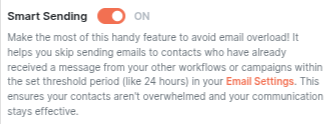
To further customize the email design in the drag-and-drop editor, click on the Edit email content button.
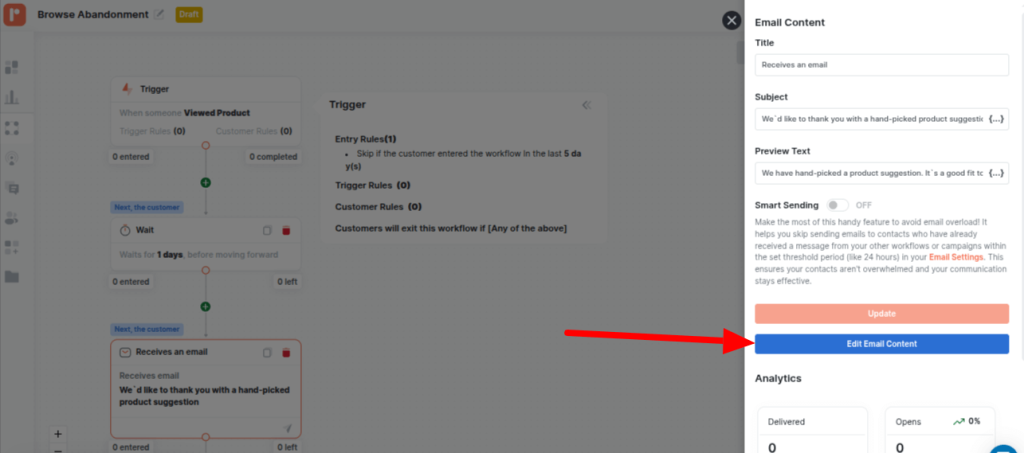
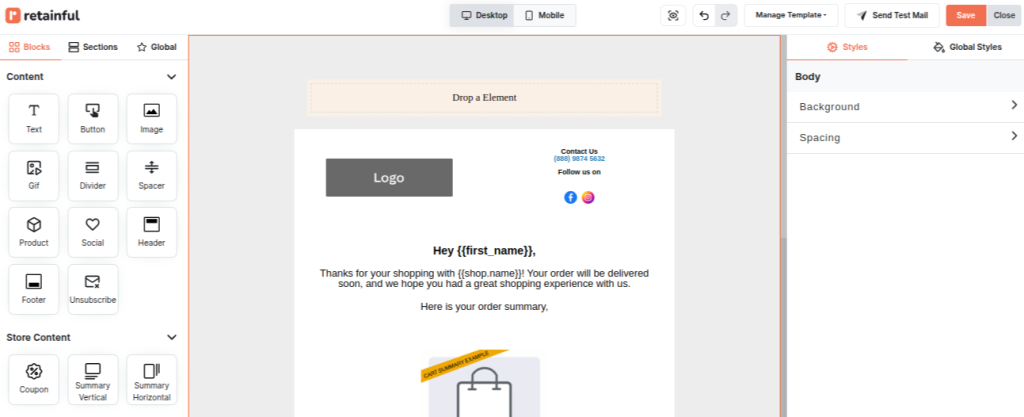
Step 4: Optionally, you can even include SMS or WhatsApp blocks
Email experts suggest sending 3 emails and 1 SMS to increase conversions in browse abandonment.
To include an SMS or WhatsApp block in your workflow, simply click on the Plus icon and choose the SMS or WhatsApp block.

Step 5: Go Llive
Once you’ve customized your workflow, hit the Start workflow button to go live.
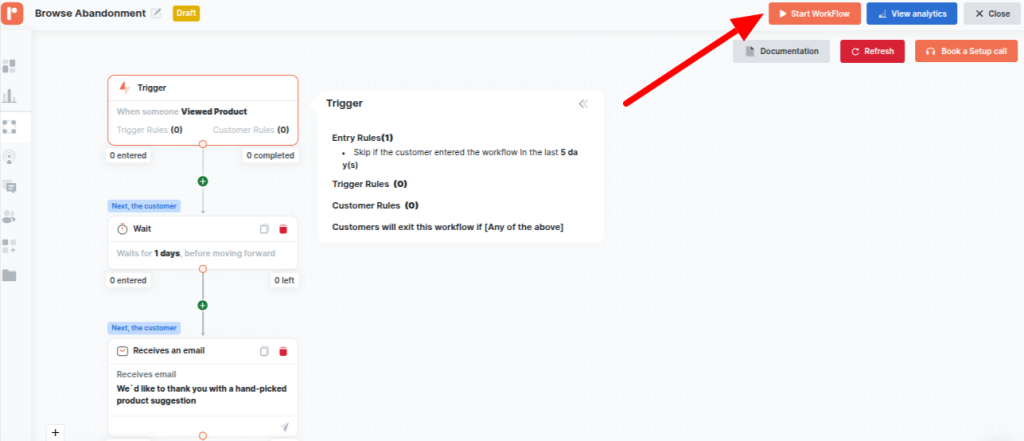
Start engaging your window shoppers today and watch the conversions roll in automatically with Retainful
Wrap up!
Browse abandonment isn’t a problem—it’s an opportunity waiting to be tapped.
Most shoppers who leave without adding items to their cart aren’t rejecting your brand; they’re simply exploring.
Combine behavior-based triggers, relevant product recommendations, trust-building content, and a smart cadence, visitors into customers.
And you don’t have to build everything from scratch.
Retainful’s pre-built browse abandonment workflows help you launch high-converting sequences in minutes.
With dynamic product blocks, SMS + WhatsApp options, smart sending, and intuitive customization, you can recover more revenue with zero complexity.
Also Read:
- 10 Free black friday email templates (examples + tips)
- Why are my emails going to spam? ( 11 Reasons + How to fix)
- Improve SMS Deliverability: The Marketer’s Guide to 95% Deliverability Rates
Frequently asked questions
A good benchmark is 0.5%–2%, with ~1% being average and anything above 2% considered strong performance.
Send Email 1 in 2–6 hours, Email 2 after 24–48 hours, and an optional Email 3 in 3–7 days with a different angle.
Yes, it is ethical and legal. If you follow privacy laws—GDPR often requires consent, while US CAN-SPAM requires clear opt-outs and compliant emailing.
Yes. Just prioritize cart abandoners and use gentler messaging for browsers, ensuring users don’t get both flows at once.
Top picks: Klaviyo, Omnisend, Retainful, ActiveCampaign, and Brevo—all offer strong e-commerce tracking and automation.



